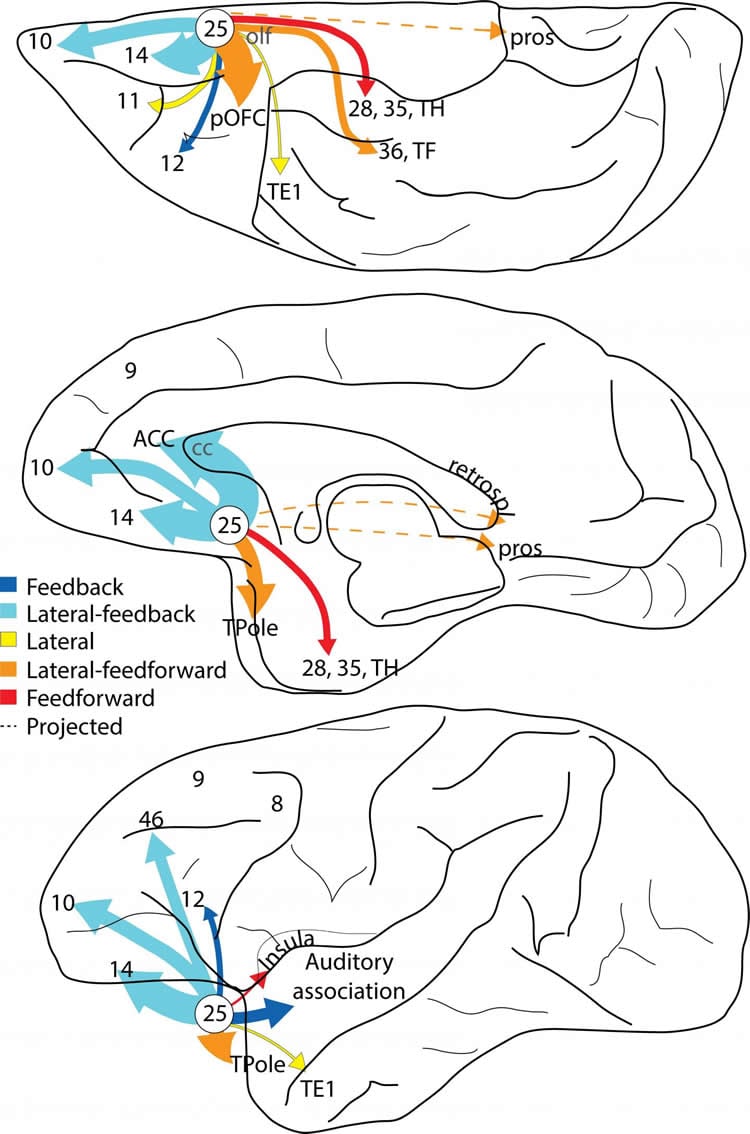Summary: Researchers have mapped pathways in the A25 region of the prefrontal cortex. The brain region is implicated in emotion and memory processes.
Source: SfN.
Neuroscientists have charted the incoming and outgoing connections of a brain region located deep within the primate prefrontal cortex that has important roles in emotion and memory processes.
The comprehensive, high-resolution map reported in JNeurosci provides new insight into how emotional regulation may become disrupted in psychiatric disorders.

By mapping pathways of subgenual cingulate area 25 (A25) of non-human primates, Helen Barbas and Mary Kate Joyce demonstrate strong connections between this brain area and others involved in emotional regulation and maintenance of body states like the stress response.
The researchers also found connections that may contribute to the emotional content of memories and a pathway between A25, which is activated during feelings of sadness, and frontopolar area 10, a part of the brain that helps regulate emotions and is weakened in depression in humans. As depression is associated with excessive activity in A25, strengthening the link between these two areas suggests a possible mechanism to help disengage from persistent negative thoughts characteristic of the disorder.
Funding: This work was supported by NIH/National Institute of Neurological Disorders and Stroke, NIH/National Institute of Mental Health.
Source: David Barnstone – SfN
Publisher: Organized by NeuroscienceNews.com.
Image Source: NeuroscienceNews.com image is credited to Joyce & Barbas, JNeurosci (2018).
Original Research: Abstract in Journal of Neuroscience.
doi:10.1523/JNEUROSCI.2363-17.2017
[cbtabs][cbtab title=”MLA”]SfN “The Ins and Outs of Area 25.” NeuroscienceNews. NeuroscienceNews, 23 January 2018.
<https://neurosciencenews.com/a25-emotion-memory-8351/>.[/cbtab][cbtab title=”APA”]SfN (2018, January 23). The Ins and Outs of Area 25. NeuroscienceNews. Retrieved January 23, 2018 from https://neurosciencenews.com/a25-emotion-memory-8351/[/cbtab][cbtab title=”Chicago”]SfN “The Ins and Outs of Area 25.” https://neurosciencenews.com/a25-emotion-memory-8351/ (accessed January 23, 2018).[/cbtab][/cbtabs]
Abstract
Cortical connections position primate area 25 as a keystone for interoception, emotion, and memory
The structural and functional integrity of subgenual cingulate area 25 (A25) is crucial for emotional expression and equilibrium. A25 has a key role in affective networks, and its disruption has been linked to mood disorders, but its cortical connections have yet to be systematically or fully studied. Using neural tracers in rhesus monkeys, we found that A25 was densely connected with other ventromedial and posterior orbitofrontal areas associated with emotions and homeostasis. A moderate pathway linked A25 with frontopolar area 10, an area associated with complex cognition, which may regulate emotions and dampen negative affect. Beyond the frontal lobe, A25 was connected with auditory association areas and memory-related medial temporal cortices, and with the interoceptive-related anterior insula. A25 mostly targeted the superficial cortical layers of other areas, where broadly dispersed terminations comingled with modulatory inhibitory or disinhibitory microsystems, suggesting a dominant excitatory effect. The architecture and connections suggest that A25 is the consummate feedback system in the prefrontal cortex. Conversely, in the entorhinal cortex, A25 pathways terminated in the middle-deep layers amidst a strong local inhibitory microenvironment, suggesting gating of hippocampal output to other cortices and memory storage. The graded cortical architecture and associated laminar patterns of connections suggest how areas, layers, and functionally distinct classes of inhibitory neurons can be recruited dynamically to meet task demands. The complement of cortical connections of A25 with areas associated with memory, emotion, and somatic homeostasis provide the circuit basis to understand its vulnerability in psychiatric and neurologic disorders.
SIGNIFICANCE STATEMENT
Integrity of the prefrontal subgenual cingulate cortex is crucial for healthy emotional function. Subgenual area 25 (A25) is mostly linked with other prefrontal areas associated with emotion in a dense network positioned to recruit large fields of cortex. In healthy states, A25 is associated with internal states, autonomic function, and transient negative affect. Constant hyperactivity in A25 is a biomarker for depression in humans, and may trigger extensive activation in its dominant connections with areas associated with emotions and internal balance. A pathway between A25 and frontopolar area 10 may provide a critical link to regulate emotions and dampen persistent negative affect, which may be explored for therapeutic intervention in depression.






